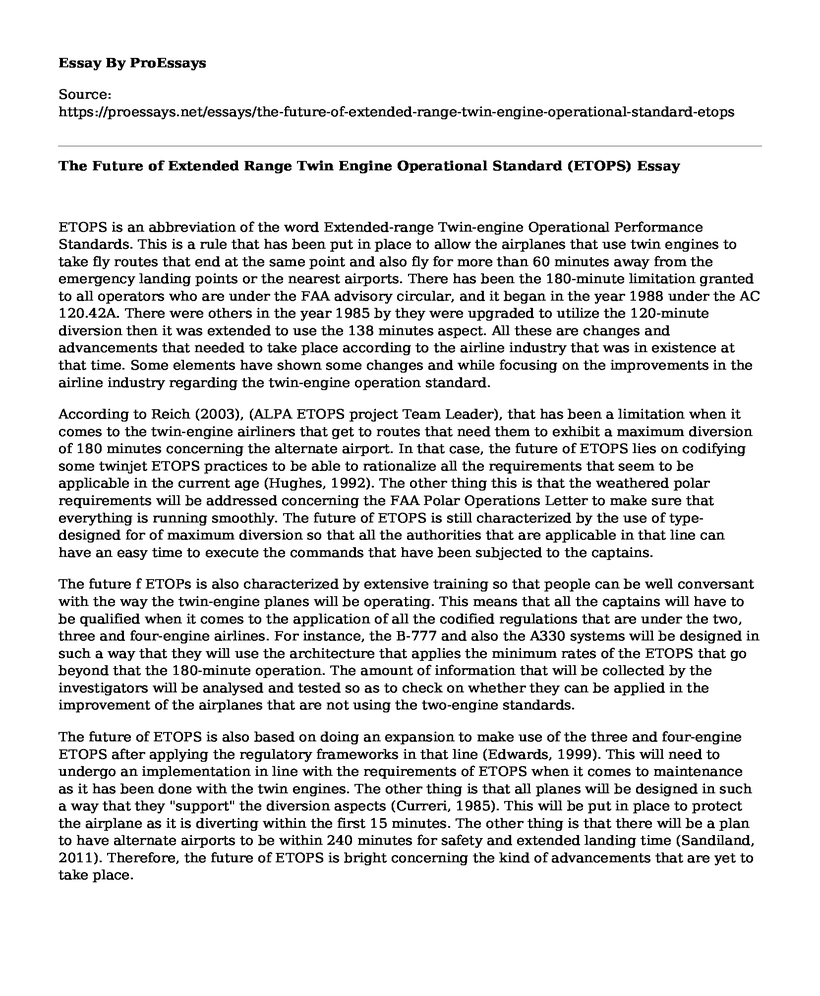ETOPS is an abbreviation of the word Extended-range Twin-engine Operational Performance Standards. This is a rule that has been put in place to allow the airplanes that use twin engines to take fly routes that end at the same point and also fly for more than 60 minutes away from the emergency landing points or the nearest airports. There has been the 180-minute limitation granted to all operators who are under the FAA advisory circular, and it began in the year 1988 under the AC 120.42A. There were others in the year 1985 by they were upgraded to utilize the 120-minute diversion then it was extended to use the 138 minutes aspect. All these are changes and advancements that needed to take place according to the airline industry that was in existence at that time. Some elements have shown some changes and while focusing on the improvements in the airline industry regarding the twin-engine operation standard.
According to Reich (2003), (ALPA ETOPS project Team Leader), that has been a limitation when it comes to the twin-engine airliners that get to routes that need them to exhibit a maximum diversion of 180 minutes concerning the alternate airport. In that case, the future of ETOPS lies on codifying some twinjet ETOPS practices to be able to rationalize all the requirements that seem to be applicable in the current age (Hughes, 1992). The other thing this is that the weathered polar requirements will be addressed concerning the FAA Polar Operations Letter to make sure that everything is running smoothly. The future of ETOPS is still characterized by the use of type-designed for of maximum diversion so that all the authorities that are applicable in that line can have an easy time to execute the commands that have been subjected to the captains.
The future f ETOPs is also characterized by extensive training so that people can be well conversant with the way the twin-engine planes will be operating. This means that all the captains will have to be qualified when it comes to the application of all the codified regulations that are under the two, three and four-engine airlines. For instance, the B-777 and also the A330 systems will be designed in such a way that they will use the architecture that applies the minimum rates of the ETOPS that go beyond that the 180-minute operation. The amount of information that will be collected by the investigators will be analysed and tested so as to check on whether they can be applied in the improvement of the airplanes that are not using the two-engine standards.
The future of ETOPS is also based on doing an expansion to make use of the three and four-engine ETOPS after applying the regulatory frameworks in that line (Edwards, 1999). This will need to undergo an implementation in line with the requirements of ETOPS when it comes to maintenance as it has been done with the twin engines. The other thing is that all planes will be designed in such a way that they "support" the diversion aspects (Curreri, 1985). This will be put in place to protect the airplane as it is diverting within the first 15 minutes. The other thing is that there will be a plan to have alternate airports to be within 240 minutes for safety and extended landing time (Sandiland, 2011). Therefore, the future of ETOPS is bright concerning the kind of advancements that are yet to take place.
References
Curreri, L. (1985). "The Practice, Philosophy, Underwriting Considerations and Future of Extended Twin-Jet Over-Water Operations ETOPS." International Air Safety Seminar Proceedings.
Edwards, T. M. (1999). "Lessons Learned in Maintaining Aircraft in ETOPS Operations." SAE Technical Paper.
Hughes, D. (1992). Air Canada Expects ETOPS success to bring faster approvals in future. Aviation Week and Space Technology, 137, 51-52
Reich, B. (2003). "The Future of ETOPS." Alpa.org. Retrieved from www.public.alpa.org/portals/alpa/magazine/2003/Aug2003_FutureofETOPS.htm
Sandiland, B. (2011). "Boeing gets twin engined long ranged limitations removed." Crikey. Retrieved from https://blogs.crikey.com.au/planetalking/2011/12/13/boeing-gets-twin-engine-long-range-limitations-removed/
Cite this page
The Future of Extended Range Twin Engine Operational Standard (ETOPS). (2022, May 26). Retrieved from https://proessays.net/essays/the-future-of-extended-range-twin-engine-operational-standard-etops
If you are the original author of this essay and no longer wish to have it published on the ProEssays website, please click below to request its removal:
- Inside of a Car - Essay Sample
- Paper Example on Design Parameters and Soil Tests
- Biography of Michael Faraday
- Project Management Tracking Approach and Its Offering to Electrical Engineering and Energy Saving Projects
- Research Paper on Petroleum Economics
- Essay Example on Shrieve Chemicals: Global Supply of Industrial Chemicals, Oil & Gas
- Paper Example on Offshore Drilling: Dangers of Fire, Spills, and Risk







